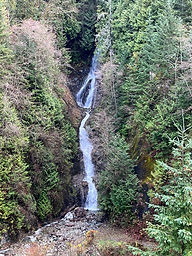Highway Redevelopment Remembered
- kc dyer

- Aug 24, 2023
- 4 min read
Resident Participation Was Key
Former mayor Douglas Miller recollects the efforts of residents and council during the pre-Olympic redevelopment of the Sea to Sky Highway.

The current repaving of the Sea to Sky highway running through Lions Bay has brought back memories of the redevelopment of the highway prior to the 2010 Olympic games.
The need for improvement of the highway predated the Olympics. The old highway followed the contour of the mountains along which it was built. Sharp curves on a two-lane, undivided road made passing difficult. Excessive speed and driver impairment added layers of danger to driving the highway and were contributing factors behind the high number of collisions and deaths every year.
The goal was to create a highway between Vancouver and Whistler that could accommodate a high volume of traffic in safe conditions.
The Ministry of Transportation and Highways (MOTH) decided the project would be a Private-Public Partnership (PPP). This involved selecting a company to design, build, and finance the project. The successful bidder would also operate and maintain the highway during the 20 years of the contract. This latter component has worked in our favour, and I’ll explain why later.
The road between Horseshoe Bay and Whistler contains many variables in topography and geology, making this a complicated and complex task.
Rather than open the bidding to all interested parties, MOTH decided to limit the number of eligible bidders to companies that were known to have the experience and financial capacity to take on such a huge project.
In order to assist the selected companies to develop competitive and financially realistic bids, MOTH decided to take a sample section of the road and hire a company to work with MOTH engineers to deal with the challenges along the entire project route. The information and data from developing that sample section of the highway would be made available to the bidders to develop the entire Sea to Sky highway project.
That sample section was a one-kilometre stretch of the highway between West Vancouver and Lions Bay. Emil Anderson Construction was contracted to do the work on a “cost plus” basis. The work included cantilevering sections of roadway, creating walls using gabion baskets and precast concrete, blasting large amounts of rock to straighten curves, crushing the resulting rock debris for use in filling depressions in the topography, etc. On top of all this, the highway had to be kept open for traffic! There were overnight closures and alternating traffic at times but the highway was open for travel most of the time.
The project impacted a number of communities between West Vancouver and Whistler. MOTH endeavoured to create cooperative relationships with these communities, particularly during the planning and design processes. While West Vancouver chose a distinctly confrontational approach with the Ministry regarding the work around Eagle Ridge, the Council here in Lions Bay decided that the Village could gain considerably more by working cooperatively with MOTH.
Rather than deal directly with the Village Council during this part of the process, MOTH requested that we form a Community Advisory Group (CAG) that would meet regularly with Ministry planners and designers to determine the factors that would work for Lions Bay and that would also fit into the budget for the project.
We were fortunate to have highly skilled and talented people in the Village who were willing to give up considerable time and expertise on behalf of our community, and their efforts were definitely positive for Lions Bay.
This is evident when comparing the highway in Lions Bay with the section that runs through the Seascapes/Ansell Place portion in West Vancouver. MOTH and our CAG went to great lengths to cooperatively develop our part of the highway to create the impression that one is driving through a community. The highway in Lions Bay is not just a straight road. The plantings in the median section are welcoming and attractive. Most importantly, efforts were made to mitigate the noise coming from the highway.
Highway noise was identified as the major problem early in the planning/design process. Our CAG attempted to have the road reduced to two lanes through the Village but this was deemed to be a non-starter. Some of the engineers on the CAG designed a covered section of roadway for the main part of the community, but building it to MOTH standards was beyond the available budget.
At one point, MOTH took a number of our CAG members over to Nanaimo to inspect a section of the road leading to the Duke Point ferry terminal. The roadway was finished with a “quiet pavement” that significantly reduced the noise of traffic. This was determined to be the best solution to the highway noise that would fit into the project budget.
MOTH agreed to our request that the quiet pavement be written into the project contract and that it be maintained throughout the term of the contract. When the pavement on the highway through Lions Bay needs to be replaced, it is to be done with the same quality of asphalt. In short, this is one reason why the PPP nature of the Sea to Sky Highway Improvement Project worked to our advantage.
In short, the efforts made by many village residents at that time ensured that we had the best possible outcome from the highway project.
Got thoughts to share about the Sea to Sky highway? The Watershed values your opinion. Leave your comments below, or email editor@lionsbaywatershed.ca








Comments